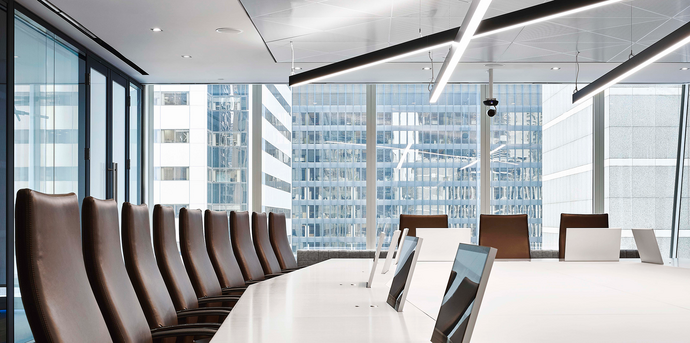Traditionally, those hours would be spent at the office. But businesses today are increasingly driven by mobility and connectivity, which makes audiovisual (AV) solutions a critical piece of modern workplace design. Connecting a well-designed office through equally well-designed AV solutions is important in order to optimize the productivity of the modern worker. Yet, typically, AV isn’t the piece that you would think about first (or even second) when designing an office. More often than not, it is the last piece of the puzzle that strikes you when you look at your beautiful new boardroom screen and think, “Wait…how do I turn this thing on?”. That’s why a good AV consultant looks at the entirety of the design – even outside their own specialty. The Smith + Andersen AV team is uniquely positioned to provide this ideal perspective, with experience as part of a multidisciplinary team that offers them unique insight into challenges facing the entire design team. On every project, our AV team looks at the four core design fundamentals of scalability, stability, functionality, and reliability. But as the workplace continues to evolve, how is adhering to these fundamentals even possible?

What are some of the most significant changes you’ve seen in office space design in the last three to five years?
Pat: I think the whole drive for collaboration has become more evident when you look at the latest office designs. Executives are moving into cubicles, and rooms are primarily used as workspaces geared specifically toward accommodating collaboration. This collaboration is reflected in the design of the space itself, but also in the technology. We’ve incorporated collaboration hardware and software solutions from Google, Cisco, Microsoft and Crestron on many of our projects, and these kinds of requests are only increasing.
Greg: More than ever, it’s all about user experience. We used to get questions like, “How will the TV turn on? How’s it going to connect?”. Now, we’re trying to improve that user experience by designing a system which asks the user to do as little as possible while the room does as much as possible. Clients want all users to have the same experience regardless of their location. The size of a boardroom or touchdown space may vary, but we try to make the touch panel interface the same so that the user knows how to perform basic functions.
What are some driving decisions behind office design that are increasingly important early on?
Greg: From our perspective, it’s all about how to make that space usable. We often collaborate with the design team so that everybody understands, for example, “This sleek, glass boardroom looks great, but…if you make this investment in this design, you need to understand the limitations you are putting on the technology that can be incorporated.” Those conversations have to happen early.
Dustin: Every corporate culture is different. Ultimately, part of our job as AV consultants is to really dig into the culture of the company. This inevitably happens at the early stages, because how a fintech culture collaborates is not the same as how a law firm collaborates. They will inevitably want to bring in different technology, will have different expectations, and their budgets will ultimately be very different. We have a number of clients that have trusted us with multiple offices - developing a standard that they can use across four or five different offices. Employees are increasingly mobile and they need to go to multiple offices. They don’t have time to spend learning a new system each time. You want the consistent experience.
Pat: Consistency is a very important decision for global offices. This goes beyond AV equipment and translates to everything. The paint colours are all the same. The furniture is all the same. If you visit an office in Hong Kong it will feel the same as the Toronto office. Early conversations about connectivity are also important. Booking panels, for example, have become commonplace, but on recent projects we have taken this a step further through the use of occupancy sensors. Someone will go into a room for a fifteen minute meeting but they booked the room for an hour. That sensor will detect when they leave the room, allowing the rest of the company to know that that room is free for other people to use. This allows for adaptable space, while also lessening the impact of bad habits from certain users.
Dustin: This is all the “Internet of Things”. Sensors and devices that provide automatic feedback are widely implemented – and they don’t just aid users. A good facility manager can then take that information and make better decisions about real estate.
How could users leverage this data?
Pat: A central monitoring system can actually give you analytics behind any installed sensors. Even when there is old technology in place, such a system can provide clients, facilities teams, and designers real data, which they can then use for space planning purposes. They can see that small meeting rooms are booked 95% of the time and larger rooms are only used 10%, so maybe the company needs more small boardrooms. We can say, “Does this room really need video conferencing? It looks like users are only using the videoconferencing feature maybe 20% of the time.” This data is driving the latest industry trends.
Tristan: On recent projects, tenant AV systems have also been tied into building lighting systems. The building lighting system will actually talk to the whole building automation system. Depending on the client, we make recommendations to take that information and make it even more useful. If an office building has automated light harvesting systems set up – either through window tinting or automatic shades – the booking system can tell the window system, “There’s about to be a presentation in here, so don’t put the shades up right now.”
Dustin: We work with the in-house IT team and the interior designers to provide the most possible options based on what the client is trying to accomplish. Our team has experience with a variety of different room types, and this collective experience – seeing how clients actually use these rooms – gives us an opportunity to help guide the design in a direction that, ultimately, will be successful long after these decisions are made.
New AV options and technology is available all the time. What’s the best way for clients to navigate these many options?
Tristan: I think it’s good to look at technology for some inspiration, but latching on to a cool new piece of technology and saying, “I have to have THAT in my space,” is typically not a successful approach. Our client could say, “I want this magic box, and I want to put it in this room.” We will respond with, “Well, what do you want to do with this room?”. Once they provide that information, we will guide them toward the best, most cost-effective box that will provide them with the most flexibility in the future.
Dustin: It’s about not getting distracted by all the latest toys. The technology, I believe, is secondary to what the business wants to accomplish in those spaces. We provide our expertise to really make sure that our clients are getting value for the technology decisions that they make. Our job is to take the very confusing world of technology – and the myriad of options – and really focus our clients on what will work for them.
How can the proper AV equipment help companies retain staff?
Pat: Again, I think it goes back to making their job easier. A good example is a whiteboard. When you use a whiteboard in a boardroom, you take notes, and then take a picture of the notes. Clients can make staff’s lives easier by using an interactive projector, so you can just press a button and email it to yourself. In every case, we try to eliminate wasted work. Why wouldn’t you want to stay at a company where your job is easier?







